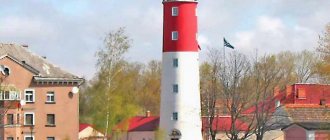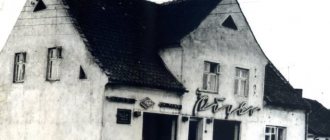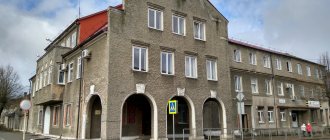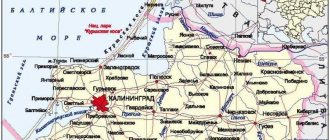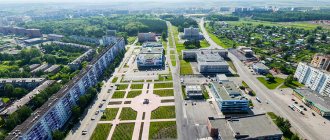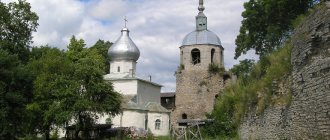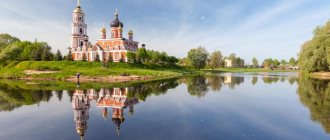About the history of the city of Bagrationovsk
Like many other Prussian cities, Preussisch-Eylau began with the construction of a castle, a stronghold of the Teutonic Order, in 1325. Unlike many other places, this castle was built from stone and brick from the very beginning (the history of most similar buildings begins with a wooden fortress, which is later converted into a stone one).
The castle was built in the form of a four-wing structure, quadrangular in shape 43 m x 41 m. On the eastern side, a large forburg was added to it - an advanced fortification (“forburg” translated from German as “in front of the fortress”). The castle chapel was located in the southern wing.
In 1400, a lightning strike caused a fire in the castle, and all its wooden structures burned out. But they were soon restored. A significant farm was kept in the castle buildings - dozens of horses, bulls and cows, hundreds of sheep and pigs. Gradually, a village grew around the castle, which was burned several times by the troops of the Poles and the Prussian Union, but was revived again.
In the 16th century, the lands of the Teutonic Order were secularized, and the castle at Preussisch-Eylau became an estate.
In 1807, on February 7-8 (January 26-27 according to the old style), a major battle took place near Preussisch-Eylau between the French and Russian-Prussian armies. The Russian army was commanded by cavalry general Bennigsen, and the French army was commanded by Emperor Napoleon Bonaparte himself, who watched the battle from the tower of the city church.
The battle claimed tens of thousands of soldiers' lives, but did not reveal a winner. Russian and Prussian troops after him were forced to retreat, and Napoleon's troops did not have the strength to pursue them. Bonaparte then lived in Preussisch-Eylau for ten days.
The Battle of Preussisch-Eylau was called by contemporaries a terrible massacre, the likes of which had not yet occurred in history since the invention of gunpowder. Some famous heroes of the future Patriotic War of 1812 took part in it and survived: in particular, Pyotr Bagration, Denis Davydov.
At the entrance to the city
In 1819, the city became the administrative center of the district of the same name. In 1835, a local district newspaper began publishing. In 1866, a railway connection opened with Königsberg (present-day Kaliningrad) and Bartenstein (after 1945 - the Polish city of Bartoszyce).
The ancient castle gradually fell into disrepair and collapsed, as did the mansion built in its place. Only the foreburg remained in a relatively strong condition.
During the Second World War, right from 1939, 7.5 km northwest of the city of Preussisch Eylau, a prisoner of war camp appeared in which the Germans held Poles, French, Belgians, and then Russians.
At the beginning of February 1945, during the East Prussian operation, Soviet troops took Preussisch Eylau, and a new history of this city began - already within the USSR.
“We’re not just going to the east”: Bagrationovsk and the surrounding area (photo, video)
In June, the editors of Kaliningrad.Ru launched a special project “Going East.” Every week we showed settlements located east of the regional center.
During this time, we traveled to 11 municipalities of the Kaliningrad region: we visited 11 cities and 14 villages, covering more than 1.6 thousand kilometers. In total, the videos of the special project “Going East” collected more than 130 thousand views, and articles with photographs received about 110 thousand.
At the request of readers, Kaliningrad.Ru is not finishing the project about the life of small towns in the region. Today we will talk about Bagrationovsk and its surroundings.
In 1325-1326, the Preussisch-Eylau fortress was founded on a hill surrounded by swamps and a river. Then the turbulent history of the land began on the site of present Bagrationovsk. The name of Preussisch-Eylau Castle was not fixed immediately: in historical documents of 1326 the building was called Ile, in records of 1342 - Iladiya, and in 1400 - Prusche Ilov.
The territory attracted German colonists. Soon the settlement grew and received the right to trade. By 1348 there were 12 taverns here. A few decades later, Preussisch-Eylau became a major trade and craft center.
In 1400, a fire in the castle destroyed all the wooden structures. It was soon restored. By that time, the fortress buildings contained a significant part of the village’s economy: more than 70 horses, 58 bulls and cows, 356 sheep, 170 pigs. After 1525 the castle became an estate. In 1858, Preussisch-Eylau acquired city status and a coat of arms with a shield.
Like many cities in East Prussia, Preussisch-Eylau was repeatedly destroyed during battles and fires, but was rebuilt. During the Napoleonic Wars in 1807, a battle between the French and Russian-Prussian armies took place near the city. In memory of this event, an obelisk monument was erected in 1856, designed by the famous architect Friedrich August Stüler.
In 1819, Preussisch-Eylau became the administrative center of the district of the same name. Then the rapid growth of the city began. Administrative and residential buildings are being actively built, and industrial production is developing. In 1866, a railway connection was opened with Königsberg and Bartenstein (now Bartoszyce, Poland).
Before the war, 7,485 people lived here. The city had a dairy, porcelain and gas factories, the production of agricultural machinery, a steam mill, and four breweries. There were also private schools and a gymnasium.
During World War II, the largest prisoner of war camp in East Prussia, Stalag 1A Stablak, was located a few kilometers from Preussisch-Eylau. Soviet, Polish, Belgian, French, and Italian employees were brought here. After the victory over fascism, the Shtablak training ground was divided between Poland and the USSR. On the Soviet side there remained a complex of buildings with the Shtablak-Nord barracks and a cemetery for prisoners of war. In 1989, a memorial was opened at the burial site.
After the war, the city became part of the USSR. In 1946, it was renamed in honor of the hero of the Patriotic War of 1812, Pyotr Ivanovich Bagration. Gradually Bagrationovsk was restored: a milk processing plant was opened, and later a bakery with modern mechanized equipment.
In September 1993, a museum of the history of the region appeared in Bagrationovsk in the building of the former district administration. By the beginning of the 21st century, the city had 7.3 thousand inhabitants. By 2012, the population had dropped to 6.6 thousand.
In Bagrationovsk, the Preussisch-Eylau castle, the rebuilt church from 1335, the post office building from 1900, the building of the Royal Teachers' Seminary from 1861, and the Schwarz house from the 1920s have been preserved. In 1997, a temple of the holy martyrs Faith, Nadezhda, Lyubov and their mother Sophia was opened here.
In addition, the district preserves the 14th-century St. Catherine's Church, the 14th-century St. Anne's Church, the Nivenskoye military airfield, the 14th-century church and the Udervangen mill from 1916.
Now about 33 thousand people live in the district, of which more than six thousand live in the city itself. The basis of the economy is agriculture, industry and trade. Companies producing refrigeration equipment, food products, furniture and pharmaceuticals operate here.
In 2022, Bagrationovsk received money for the improvement of the city park and the creation of a recreational area near the Preussisch-Eylau church and Lake Langer. Renovation work began in March. Pedestrian and bicycle paths will be built in the landscape park, sports grounds and small architectural forms will be installed. In addition, the authorities expect to create a beach with a place for playing volleyball.
On the territory of the district there are the remains of Balga Castle, the first mention of which dates back to the 13th century. Until 1239, the Honeda fortress was located here, then it was captured by the knights of the Teutonic Order. Subsequently, the convention used the building as a base for conquests.
From the middle of the 16th century, the building began to collapse, and at the end they decided to dismantle it. The stones served as material for the construction of the Pillau fortress. In 1836, local residents made attempts to preserve Balga: the roof and windows were repaired, and a local history museum was opened in the tower. During World War II, the castle was subjected to massive shelling, and after that the Amber Room was searched for in the ruins, which led to additional destruction. The ruins of a tower, the ruins of a forburg and a church have survived to this day from Balga.
Sources of information: “Objects of cultural heritage of the Kaliningrad region”, illustrated catalog edited by A.M. Tarunova, Scientific Information Publishing Center (Moscow, 2013), prussia39.ru, official website of the administration of the Bagrationovsky urban district.
Regional History Museum
For such a small town as Bagrationovsk, the Regional History Museum is very impressive. Its exposition is located in an ancient building - it housed the district government. The exhibitions occupy four halls. which compactly house unique exhibits of the history of the former German city of Preussisch-Eylau, finds from the field of the famous battle of 1807, samples of weapons, uniforms, equipment of the Russian and French armies of the early 19th century, as well as paintings, drawings, engravings, and household items of the first settlers.
The permanent exhibition of the museum has been open since September 1993. His collection tells about different eras in the history of the lands on which the current Bagrationovsky district is located.
Particular attention is paid, of course, to its most striking periods and events: the conquest of Prussian lands by German crusading knights; the emergence and development of the first cities, the grandiose battle of Preussisch-Eylau in 1807 and the military pages of the First World War, the battles in the Heilsberg fortified area in 1945 and the formation of the Bagrationovsky district of the Kaliningrad region.
The total display and exhibition area of the museum is more than 200 square meters. The main fund of the museum contains over 5 thousand storage units. Among them there are many interesting and truly unique things. For example, a 17th-century coin treasure from Preussisch-Eylau Castle, a collection of original military-historical miniatures, military awards from Russia, Prussia, and France, an interesting collection of old engravings depicting events from the era of the Napoleonic Wars.
Regional History Museum
The first hall of the museum is dedicated to the oldest inhabitants of these territories - about representatives of the Corded Ware culture, about the Prussian region of Natangia, about the castles and temples of the Teutonic Order that were and are in the territory of the present Bagrationovsky district, and about the initial period of the history of the city of Preussisch-Eylau.
The second hall is the site of the famous battle of Preussisch-Eylau, early February 1807. All sorts of rare and truly unique exhibits are collected here - finds from the battlefield: buttons of Russian and French soldiers, buckshot, bullets, part of an authentic French gun, cannonballs of various sizes. Here you can also find information about the sights of the city associated with the battle.
A significant addition to the collection occurred on the occasion of the 200th anniversary of the battle: the exposition of this thematic hall was replenished with a collection of awards from Russia, France and Prussia of the early 19th century, as well as exact copies of the uniforms and weapons of the soldiers of the armies that then fought to the death.
The third hall complements the theme of the grandiose Napoleonic wars of the early 19th century, some of which took place in East Prussia.
The fourth hall is dedicated to the history of the twentieth century. In it you can find out the details of two East Prussian operations: 1914 and 1945, and get acquainted with the life of the town of Preussisch-Eylau - as it was between the two world wars. And, of course, trace the beginning of the Russian history of Preussisch-Eylau - Bagrationovsk: documents, photographs, household items of the first settlers.
In addition to the permanent exhibition, the museum regularly hosts exhibitions of artists and masters of applied art; historical conferences. There is a Military History Club at the museum (since 2003). Its activists regularly participate in historical reconstructions.
Museum staff conduct not only tours of the museum’s halls, but also guide tours of the city of Bagrationovsk, with visits to all the sights.
Bagrationovsk (formerly Preussisch-Eylau, German Preußisch Eylau, Polish Pruska Iława) is a city in the Kaliningrad region on the border with Poland, located 37 kilometers from Kaliningrad, the administrative center of the region.
In 1325, during the colonization of the inland lands of Natangia, on the site of present-day Bagrationovsk, on the instructions of the Grand Master of the Teutonic Order Werner von Orseln and under the leadership of Balgi commander Dietrich von Altenburg, a castle was erected, designed to serve as an intermediate strong point between Kreuzburg (now the village of Slavskoye, Bagrationovsky district -na) and Bartenstein (now Bartoszyce, Poland). Initially, the castle was called Ilaw, Ilawa - a toponym often found in Poland and the Czech Republic, which later transformed into Eylau. “Proussisch” was added in order to distinguish the “Prussian” Eylau from the “German”, Deutsche Eylau (now the city of Ilawa, Poland).
A flat hill, advantageous from a military point of view, surrounded on three sides by water and swamps, was chosen for construction. Unlike many other order castles, Preussisch-Eylau was immediately built from stone and brick. In plan, it was a quadrangle measuring 43 by 41 meters, consisting of four wings with a large forburg adjacent to the east. A gate was built in the eastern wing; in the southern wing there was an indispensable attribute of the order's castle - the castle chapel. Until 1347, the residence of the order's pfleger was located here, and later the administration of the chamberat.
The first mention of a settlement (lischka) that arose near the castle walls dates back to 1348; it bore the name Neuhof, “new courtyard,” typical for these places.
Preussisch-Eylau took an active part in the Thirteen Years' War of 1454-1466. At first the castle was captured by the rebels of the Prussian Union, but was subsequently recaptured from them by the knights of the order. Later, a detachment of the Prussian Union under the command of Remshel von Kriksen besieged it and tried to take it by storm, but encountered stubborn resistance from the garrison, and reinforcements arrived from Königsberg and lifted the siege. During the war, the enemy made two more unsuccessful attempts to capture the castle - in October 1455 and March 1456.
In 1520, Preussisch-Eylau again participated in the war - this time between Duke Albrecht of Brandenburg and King Sigismund of Poland. The Poles burned the settlement, but they also failed to take the castle.
In 1585, after the reformation in Prussia, Preussisch-Eylau became the seat of Hauptmann and received city rights (in 1700, Hauptmann was abolished).
The most significant event in the life of Preussisch-Eylau, which inscribed his name in history, occurred in February 1807, when the French (Napoleon) and Russian (Bennigsen) armies met near the city in the bloodiest battle of the Russian-Prussian-French war. During the battle, which did not bring a decisive victory to either side, the city changed hands twice.
In 1819, Preussisch-Eylau became the administrative center of the district of the same name. Since 1835, a district newspaper has been published in the city, in 1861 the building of the Royal Teachers' Seminary was built, and since 1866, a regular railway service runs through the city between Königsberg and Bartenstein.
During the First World War, Preussisch-Eylau was briefly occupied by the Russian army. There were no active hostilities in this area, and the city was not damaged.
In 1932, a regional local history museum was opened in an old mansion not far from the gradually deteriorating castle.
On February 10, 1945, Soviet troops captured the city during the East Prussian operation. On September 7, 1946, Preussisch-Eylau was renamed Bagrationovsk in honor of the hero of the Patriotic War of 1812, the outstanding Russian commander Pyotr Ivanovich Bagration, who participated in the battle of Preussisch-Eylau. A bust of the general is installed in the central square of the city; one of the main streets also bears his name.
In 1961, the castle and the forburg, which had almost completely fallen into disrepair, were transferred to the Bagrationovskaya office of the regional consumer union; in 1990, the forburg was finally destroyed as a result of a fire. In the mid-1990s, renovation work was carried out at the castle with the aim of converting it into a hotel, but they were not completed, and currently the building is in a state of disrepair, gradually collapsing. In 2002-2003 The Sambian-Natangen archaeological expedition led by K. N. Skvortsov clarified the location and location of individual elements of the castle.
The attractions of Bagrationovsk include:
- preserved historical buildings, including the Royal Teachers' Seminary (now the city administration), the Museum of the History of the Preussisch-Eylau District (now the Bagrationovsky Museum of Regional History), house number 9 on Central Street (formerly Landsbergstrasse), standing on the site of the building in which 7 until February 17, 1807 Napoleon Bonaparte lived, the city post office, the district court building and others, - the city and railway water towers, - the Temple of Faith, Hope, Love and their mother Sophia (an active church), - a memorial stone to the victorious Soviet soldier, - a mass grave of Soviet soldiers, - burial of 14 Russian, 1 Romanian and 6 German soldiers who died in the First World War, - a memorial stone for the residents of Preussisch-Eylau, installed in 2008 at the expense of descendants, - an indicator of the distance to European capitals, installed in the center cities.
On the territory of Bagrationovsk there are lakes Langer and Varshkaity, and three streams flow through. The A-195 highway passes through the city, ending at the Bagrationovsk-Bezledy border checkpoint.
Historical, cultural and recreational cluster “War and Peace”
In 2022, the excellent Historical, Cultural and Recreational Cluster “War and Peace” opened in Bagrationovsk. His project won the All-Russian competition “Formation of a Comfortable Urban Environment”, and therefore received 100 million rubles for its implementation.
Historical, cultural and recreational cluster “War and Peace”
The War and Peace cluster includes many sports fields, walking and cycling paths, a city beach with a boat station, volleyball and children's playgrounds; a historical and artistic space in the form of a picturesque square, barbecue areas, an observation deck, a drive-in cinema, an entrance pavilion with a bicycle rental point, and a wake park.
Location: on the eastern shore of Lake Langer.
Monument to Pyotr Ivanovich Bagration
The monument to the infantry general Prince Pyotr Ivanovich Bagration, famous for his bravery, was erected on the Central Square of the city in May 1954.
The bust by sculptor Avramchenko is made of plaster and painted with bronze paint. It was installed on a concrete pedestal lined with tiles. There is a marble plaque on it with an inscription carved on it, briefly telling about the years of life of the outstanding commander and his exploits.
Monument to Pyotr Ivanovich Bagration
According to the decree of the government of the Kaliningrad region dated March 23, 2007 No. 132, the monument to Pyotr Ivanovich Bagration was given the status of an object of cultural heritage of local (municipal) significance.
Location: Central square.
Indicator of distances to European capitals
There is another interesting monument on the city’s Central Square: an indicator of distances to European capitals. It is an obelisk crowned with a double-headed eagle, mounted on a pedestal in the shape of a parallelepiped. On its edge are the names of European capitals, with the kilometers of distances to them.
Indicator of distances to European capitals
Location: Central square.
Monument in honor of the Battle of Preussisch Eylau
Near the exit from the city there is a monument in honor of the Battle of Preussisch Eylau. It is made in neo-Gothic style. The monument is a majestic tetrahedral obelisk, 10.66 meters high, which is surrounded by a fence, and two ancient cannons on its sides. The monument was built in 1854-1856, by order of the Prussian king Friedrich Wilhelm IV.
The inscription on it: “To the glorious memory of Lestocq, Dirik and their brothers in arms” (in German) says a lot. Among the “brothers in arms” is Bennigsen, a Russian general, but an ethnic German. Not mentioning it in this case is like erasing the Soviet Union from the history of World War II.
Monument in honor of the Battle of Preussisch Eylau
Nevertheless, the bas-relief image of Bennigsen was still applied to the pedestal (in the decorative niches there you can see relief sculptural portraits of three generals: Anton Wilhelm Lestock, Christov Friedrich Otto von Dierick and Leonty Leontyevich (Levin August Gottlieb Theophile) Bennigsen.
Two cannons from the Franco-Prussian War, cast in 1874, with carriages from 1879, were added to the composition of the monument in 1907 - on the eve of the centenary of the great battle.
Location: st. Friendship, on the outskirts of the city along the eastern highway.
Bagrationovsk – Preussisch-Eylau – city of Russian glory
The Battle of Preussisch-Eylau (now the city of Bagrationovsk in the Kaliningrad region) is often referred to in historical literature as a senseless massacre that did not bring any benefit to any of the warring parties. The words of Marshal Ney are often quoted: “What a massacre, and without any benefit!” Meanwhile, this battle, which took place on February 7–8, 1807, was one of the most striking examples in the history of the Napoleonic wars of how Napoleon’s French army, which was considered invincible, met with an equal enemy - the Russian army (and equal is at least) and couldn't defeat him. In the period between the Second Italian Campaign (with its famous Suvorov campaign) and until the winter of 1806–07, the great Corsican invariably achieved the defeat of the enemy. In the same campaign, known as the Russian-Prussian-French War or the War of the Fourth Coalition, the Russian army once again showed Bonaparte that war could not always go according to his plan and according to his rules.
Charles Meinier. Napoleon's entry into Berlin on October 27, 1806
This time the Russians were unable to save Prussia from defeat and from French occupation. Therefore, in fact, most authors of that time considered military confrontation between the Russian and French armies useless. For Napoleon, the entire winter campaign of 1806–07 also turned out to be essentially useless: the fate of Prussia was already virtually decided and it was very difficult to achieve anything more. And most importantly, he clearly did not learn anything when he decided to go on a campaign against Moscow in 1812, ignoring the noticeable psychological effect that the ability of the Russian command to wage war according to its own rules, the tactical literacy of officers, and the courage and training of Russian soldiers had on the French. And, of course, not least - their unsurpassed skill in rapid maneuver, as well as hand-to-hand and bayonet combat. It’s just that from the point of view of Napoleon and his marshals, this advantage could be compensated by numerical superiority. However, concluding the Peace of Tilsit at the end of the war, Napoleon pointedly refused to conduct any negotiations with representatives of Prussia. By the way, it was not at all in his character to show sufficient respect for the enemy. However, Bonaparte had to meet with the Russian Emperor Alexander I in person.
But from the point of view of Russian interests, everything was not so simple. This little-known war was something of a testing ground for the development and formation of Russia’s own tactics and strategy, with the help of which, as the War of 1812 showed, it was possible to outplay Napoleon. And perhaps, if not for the bloody draw in 1807, the victory of 1812 would have been much more difficult for us. But let's not get ahead of ourselves.
The War of the Fourth Coalition was started by Prussia (either it was forced or provoked, depending on how you look at it), feeling the support of England and Russia. However, at the same time, King Frederick William III clearly overestimated the capabilities of his army and did not ask for direct help from Alexander I. Napoleon, not without grace, defeated the main forces of the Prussian army in a victorious double battle near Jena and Auerstadt and took Berlin almost without resistance (October 12, 1806). By the end of the year, the kingdom's territory had shrunk to several small areas, mainly in East Prussia. But the final defeat was still far away, as Russian troops finally came to the aid of Friedrich Wilhelm.
The army was commanded by an outstanding Russian commander, a representative of an ancient Lower Saxon family, cavalry general Leonty Leontievich (by birth - August Gottlieb) Benningsen. Among his subordinates there were quite a few names that became known throughout the world after 1812. However, some of them have already been glorified in Russia, like de Tolly and Bagration, and some are still completely unknown - Denis Davydov, for example. But besides the famous names, it is much more interesting to find certain parallels in the general course of both campaigns - the winter of 1806–07 and the Patriotic War of 1812.
From the very beginning, the Russian army stubbornly avoided a general battle - both armies maneuvered throughout December, preventing each other from choosing an advantageous position in the territory east of the lower Vistula - in Mazovia and East Prussia. In three fierce battles - near Charnov, Golymin and Pultusk - the main forces of the opponents were never involved. There were no clear winners in these battles, but the Russians abandoned their positions, after which they accumulated forces in other places. This alone should have infuriated Napoleon, and, besides, the Russian army demonstrated clearly superior mobility and ability to move in an organized and fast manner. Several times the Russians appeared in a matter of days where they were not expected at all, although they never dealt a decisive blow to the French.
The main task of the Russian army in this grueling game was to prevent Napoleon from concentrating his forces south of Königsberg. From this direction it was most convenient to launch a decisive attack on the temporary capital of the kingdom and the only major city not yet captured by the French. It is also necessary to explain that eighty percent of the military art of that time consisted of the ability to gather in a designated place and time all the corps moving separately (usually numbering no more than 20,000 people) in order to deliver a decisive blow. But East Prussia and Mazovia at that time were not generally distinguished by good roads, and even those were separated by impassable forests and swamps. The transition of a large army in a latitudinal direction from West Prussia to East Prussia was practically impossible in winter, and a roundabout maneuver (through the Mazovsky swamps and Insterburg) was too risky. In general, it all came down to mutual maneuvering, to the fact that the French tried to assemble separate corps in parts in the southern direction, and the Russian army and the distance from supply bases hindered them.
In January, the strength of both armies began to deplete, due to the weakness of supplies on both sides, illness and constant grueling marches. Both armies were clearly trying to exhaust and weaken each other, avoiding major clashes (most of the forces were in winter quarters), but there was no talk of ending the war. A long war of maneuver, as a rule, until a certain time only strengthens the determination of the parties to end the war with one decisive battle. The long-awaited moment unexpectedly arrived on January 20, when Marshal Michel Ney, on his own initiative, moved significant forces, mostly cavalry, (about 35 thousand people) to an area about 70 kilometers south of Königsberg. Whether he wanted to impose a major battle here is an ambiguous question (most likely, at first the desperate situation with supplies forced him to go into an open clash with the Russians). But Benningsen and his military leaders took this unexpected move quite clearly.
Part of the Russian army by that time was concentrated in Warsaw, where the fairly exhausted regiments were regaining their strength and receiving reinforcements. By order of Benningsen, about 20 thousand soldiers remained to cover Warsaw, and the main forces of the Russian army marched north, with the goal of bypassing them from the east as quickly as possible, covering almost twice the distance.
The question of why they bypassed and overtook the French, and did not hit Neya in the rear (as Suvorov would probably have tried to do: “fall out of the blue”), can only be answered with assumptions. There was an order to urgently join the main forces; there was no accurate information about the location and number of the French. And, most likely, it was difficult to concentrate forces to deliver such a blow: the march took place along a bad, secondary road and the regiments were stretched out (the formation lasted for several days).
Napoleon, in turn, also gave orders to his marshals to go to the aid of Ney. All of them were with their corps on opposite sides of the Vistula at quite large distances from each other - from Plock to Bydgoszcz - and were obviously preparing to wait out the winter there.
The main part of the Russian army under the direct command of Benningsen was at that time between Königsberg and the mouth of the Vistula. From here it was very convenient for him to strike at the nearest and not the most numerous corps of Jean-Baptiste Bernadotte, who crossed the Vistula at Thorn and was coming to the aid of Ney.
In order to divert at least part of the forces of the Russian army from the main direction, Bonaparte after some time ordered Bernadotte to retreat, trying to draw Benningsen to the west. The corps of Murat and Davout continued to come to her aid. At this time, frosts finally hit, the roads became well passable and Napoleon’s plan could well have come true if not for Benningsen’s caution. Let us note that the French have acted in a similar way more than once (distracting one part of the enemy’s forces while simultaneously concentrating against another - one of Bonaparte’s favorite techniques, which he brought to perfection). By the way, this happened quite recently near Jena and Auerstadt, so it was apparently not difficult to guess the intentions of the great commander. Benningsen did not pursue Bernadotte and by February 3 (this and all subsequent dates - according to the new style) united with the troops that approached from the south, overtaking the French. Here again it is worth noting the high speed of movement of Russian troops (Suvorov school). The forces of the French army by this time amounted to 60,000 - 65,000 people. The size of the Russian army exceeded 70,000 people. In addition, the Russians had 400 guns against the French 300.
Realizing that it was not possible to entice part of the Russian forces with Bernadotte’s imaginary retreat, Napoleon ordered the marshals to advance, trying, if possible, to envelop the Russian troops from the flanks and take advantage of their fatigue after a long march. For three days in a row, the French stepped on the Russians' heels, preventing them from gaining a foothold and preparing for a big battle, but they were never able to achieve encirclement.
The first major and very violent clash occurred on the morning of February 7th. The rearguard under the command of Lieutenant General from the Infateria Pyotr Ivanovich Bagration did not allow the French to immediately occupy the small town of Preussisch-Eylau. Thanks to this attack, the main forces of the Russian army were able to take advantageous positions on the heights north of the city. For the two, exhausted by long maneuvers and the deprivations inevitable for such a war, this was a long-awaited moment. Therefore, the rearguard battle, followed by the abandonment of the city, almost without a break turned into a firefight and a large-scale artillery duel.
(To be continued)
Monument at the mass grave of Soviet soldiers
Until the end of the war, in the city of Preussisch-Eylau there was a hospital in the school building, and soldiers and officers who died from their wounds were buried next to it. Then the remains of Soviet soldiers who died and were buried by their comrades in the vicinity of the town were transferred here. In total, about 1.6 thousand soldiers were collected in this mass grave, including Hero of the Soviet Union, Lieutenant Colonel Nikolai Kovalev, who died on March 17, 1945 in the vicinity of Preussisch-Eylau. The monument was erected in 1957, and in 1970 it was seriously strengthened and repaired.
Monument at the mass grave of Soviet soldiers
Location: st. Sports, north of the school stadium.
Picturesque Bagrationovsk
Bagrationovsk (until 1946 Preussisch-Eylau or “the pearl of Prussia”) is a small town 45 km from Kaliningrad, with a population of no more than 7 thousand people. Here you can see Europe at arm's length - the Bagrationovsk-Bezledy border checkpoint is only 1.5 km away.
Bagrationovsk is famous for the fact that this is the place where Napoleon suffered his first Fiasco in his military career during the battle in 1807. The modern name of the city is given in honor of the brave commander who made a significant contribution to the defeat of the French, Pyotr Ivanovich Bagrationov.
Interesting!
Leo Tolstoy, in his novel War and Peace, describes in detail the battle of Preussisch-Eylau in 1807.
The town, although a “district”, is very neat and picturesque - hills, lakes and old Prussia. Everything here speaks of the Prussian past - paving stones, entire streets of German houses with characteristic tiles and interesting architectural monuments.
Main attractions of Bagrationovsk
Almost all the city's attractions are located in the center area. The first of them is a bust of P.I. Bagrationov on the central square.
Nearby is the Bagrationovsky Museum of Regional History on the street. Kaliningradskaya, 10. The museum with 4 halls and 4,000 exhibits is located in the historical building "Kreishouse" (former administration) 1900-1901.
From the Prussian administration we will go to the most beautiful church in the city and even in the country - the Orthodox Church of the Holy Martyrs Faith, Hope, Love and their mother Sophia (Krasnoarmeyskaya St., 52).
Not far from the temple on the street. The brick foreburg of the Order's castle from 1325 is the only thing that has survived from the Preussisch-Eylau castle. Projects to restore the forburg did not materialize and the ancient structure is gradually being destroyed.
The modern city administration is located in the beautiful building of the former Royal Teachers' Seminary of 1859-1861 (Pogranichnaya St., 56). As you leave the city to view the obelisk, you can see the water tower on the street along the way. Bagrationova.
Let's finish the review with an 11-meter obelisk erected in honor of the Battle of Preussisch-Eylau in 1807 along Friendship Street at the southern exit of the city. It is in this city that military history buffs come to reenact the events of the 1807 battle.
Tourists with personal transport can visit the village of Vladimirovo - here you can find the Tarau Church of the 14th century. There is a legend that it was in this church that the poet Simon Dach fell in love with the daughter of a local pastor, Ankhen, and composed poems that became the song “Ankhen from Tarau.”
Memorial complex to prisoners of the Stalag 1A concentration camp
A few kilometers from the city there is a memorial complex “International Cemetery for Prisoners of the Stalag 1A Concentration Camp”. This concentration camp existed from 1939 until the end of the Great Patriotic War. The dead prisoners were buried next to him, in the cemetery. In 1971, on the initiative of the French authorities, the remains of 164 French prisoners of war were exhumed and taken away for reburial at home.
In 1989, a memorial appeared at the cemetery. This is a rectangular area, in the center of which there is a sculptural composition, and around it there are tombstones and slabs with images of the emblems of states whose prisoners of war died and were buried here.
Population
School
- 1782: 1,453
- 1804: 1,816
- 1820: 1,631
- 1846: 2,630
- 1852: 2,988
- 1871: 3,719
- 1885: 3,547
- 1890: 3,446 (including 42 Catholics, 42 Jews)
- 1900: 3,248
- 1910: 3,270
- 1925: 3,787
- 1933: 4,123
- 1939: 7,485 people (including 1,185 military personnel)
- 1946: 2,275 (including 1,339 Germans)
- 1968: 4,300
- 1989 Census: 6,728[11]
- 2002 Census: 7,216[12]
- 2010 Census: 6,400[4]
Monument to a signal cadet
The sculpture in the style of Soviet socialist realism used to stand at the checkpoint of the military unit. In 1966-1972 in Bagrationovsk there was a military-technical school that trained liaison officers for the border troops. And then - training (school for non-commissioned officers), preparing specialists for radar and searchlight stations of the border troops. The monument remains as a reminder of those times.
Monument to a signal cadet
Location: st. Utina, 30 m southeast of houses 22, 24.
Forburg of Preussisch Eylau Castle
The castle stood on a hill, and it has not survived to this day. Below there is a preserved fort, or rather, a huge building that was part of it - with a peaked roof, built around 1350.
It is the largest medieval Prussian building in the Kaliningrad region. It is believed that it contained the economic building of the castle - warehouses, stables. All that was left of the castle were ruins, sticking out of the ground no more than a couple of meters. And you can go into the foreburg, and from its upper floors you can see where the territory of Russia ends and Poland begins.
Forburg of Preussisch Eylau Castle
During the Great Patriotic War, the forburg survived. But the condition of its interior was still very dilapidated, and in the post-war years they were no longer in use - only for some time they were used as warehouses. Attempts to renovate the foreburg were made in the 1990s and 2000s, but were not completed.
Address: st. Brick, 17.
Mamonovo - a place of storks and axes
Mamonovo (until 1947 Heiligenbeil) is a very ancient city on the sea, the first mention of which dates back to 1249. The name of the city initially sounded like Heiligenstadt (Holy City), and then Heiligenbill (bill from "saw" - fortress) and, ultimately, Heiligenbeil ("bill" - axe). This became the city’s coat of arms - two crossed axes.
Interesting!
The city could be called “Aistovo” - the nests of these beautiful birds are everywhere.
There are plenty of historical artifacts in Mamonovo, but an unprepared tourist can pass them by, seeing only a “can of sprat.” Therefore, you need to sketch out a route - and go ahead!
Let's start the walk from the street. Evseev, where in house 11 we find the Mamonovsky City Museum. It is located in an unusual pre-war building in connection with the building of the former city bathhouse. Unfortunately, it is not always possible to catch the museum caretaker.
Then we go to the street. Evseeva, 2 to the neat House of Culture and the famous “monument to sprats” of 2008, which was erected in honor of the start of production of these canned foods at a local factory.
We are heading to the intersection of the street. Central and Soviet, where the monument to N.V. Mamonov. Now we are very close to the post office building No. 450 on the street. Central, 6, which was built at the end of the 19th century and is still used for its intended purpose. Across the road is a perfectly preserved courthouse (now the State Traffic Safety Inspectorate) built in 1896.
Exercise:
At the base of almost every ancient building you can find foundation stones with the date of construction.
And finally, along the street. Oktyabrskaya, 10 there is a one-of-a-kind private museum of bricks by Dmitry Shilov, where samples of bricks from all possible materials and from different eras are presented - with brands, signs, dates, “matryoshka dolls” and “riddles” and other unique types. To see all 2,500 exhibits, you need to arrange a tour in advance by phone (+7 (9062)-10-10-43).
If you have time and transport, just a few kilometers from the city there are the ruins of Balga Castle, which is more than 700 years old - a very mysterious and no less romantic place.
Ancient Prussian buildings
Bagrationovsk has preserved many colorful old buildings built in Germany. Among them -
- fire station building with a five-story tower, st. Irkutsk-Pinsk Division, 17 – used for its original purpose and now;
- Financial management building, st. Utina, 5 – two-story, with a sharp tiled roof;
- building of a higher women's private school, on the street. Kaliningradskaya, 22;
- gym building built in 1927, on the street. Pogranichnaya, 70;
- bakery of Friedrich Wormuth, on the street. Kaliningradskaya, 30;
- Schwartz's house (Pogranichnaya St., 62) and Schwartz's villa (Pogranichnaya St., 64);
- chapel (Kaliningradskaya str., 32);
- post office built in 1900, on the street. Kaliningradskaya, 25;
- charity house on the street. Irkutsk-Pinsk Division, 24; water towers - city and railway;
- The railway station building, built in the early 20th century, is used for its intended purpose, but no passenger trains run to Bagrationovsk.
Former Charity House, 1882-1884. buildings, now a hospital
